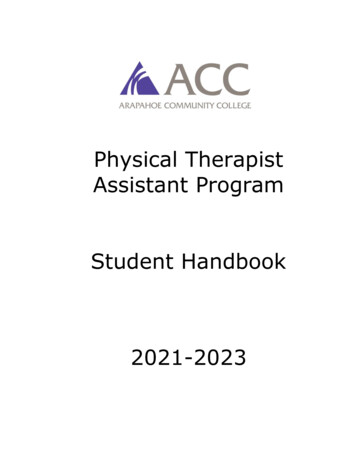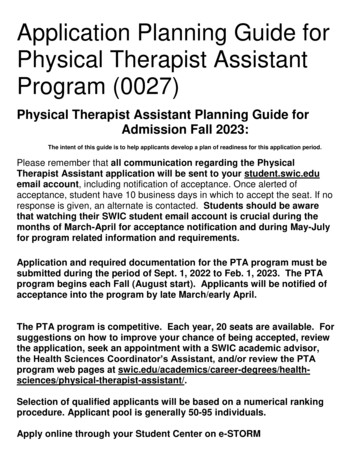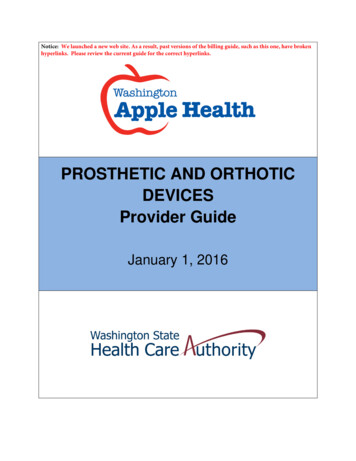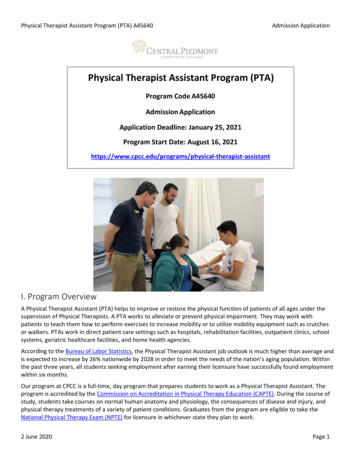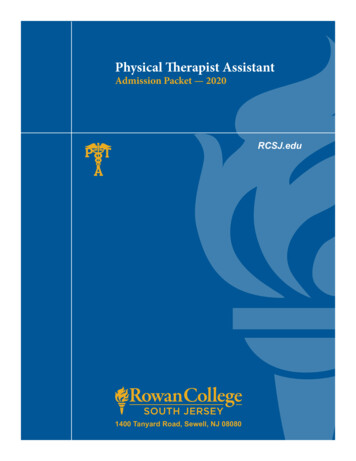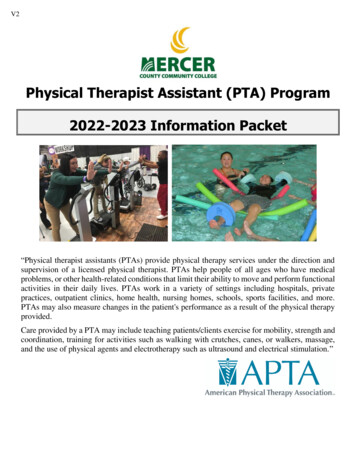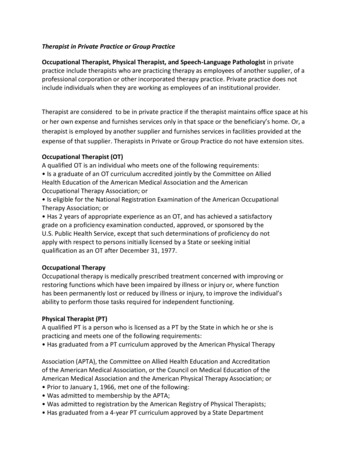
Transcription
Therapist in Private Practice or Group PracticeOccupational Therapist, Physical Therapist, and Speech-Language Pathologist in privatepractice include therapists who are practicing therapy as employees of another supplier, of aprofessional corporation or other incorporated therapy practice. Private practice does notinclude individuals when they are working as employees of an institutional provider.Therapist are considered to be in private practice if the therapist maintains office space at hisor her own expense and furnishes services only in that space or the beneficiary’s home. Or, atherapist is employed by another supplier and furnishes services in facilities provided at theexpense of that supplier. Therapists in Private or Group Practice do not have extension sites.Occupational Therapist (OT)A qualified OT is an individual who meets one of the following requirements: Is a graduate of an OT curriculum accredited jointly by the Committee on AlliedHealth Education of the American Medical Association and the AmericanOccupational Therapy Association; or Is eligible for the National Registration Examination of the American OccupationalTherapy Association; or Has 2 years of appropriate experience as an OT, and has achieved a satisfactorygrade on a proficiency examination conducted, approved, or sponsored by theU.S. Public Health Service, except that such determinations of proficiency do notapply with respect to persons initially licensed by a State or seeking initialqualification as an OT after December 31, 1977.Occupational TherapyOccupational therapy is medically prescribed treatment concerned with improving orrestoring functions which have been impaired by illness or injury or, where functionhas been permanently lost or reduced by illness or injury, to improve the individual’sability to perform those tasks required for independent functioning.Physical Therapist (PT)A qualified PT is a person who is licensed as a PT by the State in which he or she ispracticing and meets one of the following requirements: Has graduated from a PT curriculum approved by the American Physical TherapyAssociation (APTA), the Committee on Allied Health Education and Accreditationof the American Medical Association, or the Council on Medical Education of theAmerican Medical Association and the American Physical Therapy Association; or Prior to January 1, 1966, met one of the following: Was admitted to membership by the APTA; Was admitted to registration by the American Registry of Physical Therapists; Has graduated from a 4-year PT curriculum approved by a State Department
of Education; orWas licensed or registered prior to January 1, 1970, and had 15 years of fulltime experience in PT under the order and direction of attending and referringdoctors of medicine or osteopathy; or Has 2 years appropriate experience as a PT and has achieved a satisfactory gradeon a proficiency examination conducted, approved, or sponsored by the PublicHealth Service, except such determinations of proficiency do not apply with respectto persons initially licensed by a State or seeking qualification as a PT afterDecember 31, 1977; or Were trained outside the United States and graduated since 1928 from a PTtherapy curriculum approved in the country in which the curriculum was locatedand in which there is a member organization of the World Confederation forPhysical Therapy.Physical TherapyPhysical therapy services are those services provided within the scope of practice ofphysical therapists and necessary for the diagnosis and treatment of impairments,functional limitations, disabilities, or changes in physical function and health status.Speech-Language Pathologist (SLP):A qualified SLP for Medicare Program coverage purposes must meet thefollowing requirements: Be legally authorized (if applicable, licensed, certified, or registered) to engagein the private practice of SLP by the State in which the SLP practices, and practice only withinthe scope of the SLP’s license and/or certification. Engage in the private practice of SLP as an individual, in one of the followingpractice types: An unincorporated solo practice; An unincorporated partnership or unincorporated group practice; An unincorporated solo practice, partnership, or group practice, or a professional corporationor other incorporated SLP practice; An employee of a physician group; or An employee of a group that is not a professional corporation.Speech-Language PathologySpeech-language pathology services are those services provided within the scope ofpractice of SLPs and necessary for the diagnosis and treatment of speech andlanguage disorders.To be reimbursed for Medicare:
Complete the Form CMS-855B for enrollment as a physical/occupational therapy group in aprivate practice and the Form CMS-855I to enroll as an OT, a PT, or a SLP in private -Forms/index.htmlTherapist must meet the qualification for an OT, PT, or SLP to enroll in Medicare and meet thefollowing requirements: e/Manuals/Downloads/pim83c15.pdf15.4.4.9 - Occupational Therapists in Private Practice(Rev. 519, Issued: 05-30-14, Effective: 07-31-14, Implementation: 07-31-14)A. Private PracticeSection 42 CFR 410.59(c)(ii), (iii), and (iv) state that an occupational therapist in private practicemust:(1) Engage in the private practice of occupational therapy on a regular basis as an individual, inone of the following practice types:(a) An unincorporated solo practice.(b) A partnership or unincorporated group practice.(c) An unincorporated solo practice, partnership, or group practice, or a professionalcorporation or other incorporated occupational therapy practice.(d) An employee of a physician group.(e) An employee of a group that is not a professional corporation.AND(2) Bill Medicare only for services furnished in his or her private practice office space, or in thepatient's home.(a) A therapist's private practice office space refers to the location(s) where the practice isoperated, in the state(s) where the therapist (and practice, if applicable) is legally authorized tofurnish services, during the hours that the therapist engages in practice at that location. Whenservices are furnished in private practice office space, such space must be owned, leased, orrented by the practice and used for the exclusive purpose of operating the practice.(b) A patient's home does not include any institution that is a hospital, a CAH, or a SNF.AND(3) Treat individuals who are patients of the practice and for whom the practice collects fees forthe services furnished.B. Regulatory DefinitionSection 42 CFR § 484.4 defines an occupational therapist as an individual who:(1)(a) Is licensed or otherwise regulated, if applicable, as an occupational therapist by the statein which practicing, unless licensure does not apply;(b) Graduated after successful completion of an occupational therapist education programaccredited by the Accreditation Council for Occupational Therapy Education (ACOTE) of theAmerican Occupational Therapy Association, Inc. (AOTA), or successor organizations of ACOTE;and
(c) Is eligible to take, or has successfully completed the entry-level certification examination foroccupational therapists developed and administered by the National Board for Certification inOccupational Therapy, Inc. (NBCOT).OR(2) On or before December 31, 2009-(a) Is licensed or otherwise regulated, if applicable, as an occupational therapist by the state inwhich practicing; or(b) When licensure or other regulation does not apply-(i) Graduated after successful completion of an occupational therapist education programaccredited by the Accreditation Council for Occupational Therapy Education (ACOTE) of theAmerican Occupational Therapy Association, Inc. (AOTA) or successor organizations of ACOTE;and(ii) Is eligible to take, or has successfully completed the entry-level certification examination foroccupational therapists developed and administered by the National Board for Certification inOccupational Therapy, Inc., (NBCOT).OR(3) On or before January 1, 2008-(a) Graduated after successful completion of an occupational therapy program accreditedjointly by the committee on Allied Health Education and Accreditation of the American MedicalAssociation and the American Occupational Therapy Association; or(b) Is eligible for the National Registration Examination of the American Occupational TherapyAssociation or the National Board for Certification in Occupational Therapy.OR(4) On or before December 31, 1977-(a) Had 2 years of appropriate experience as an occupational therapist; and(b) Had achieved a satisfactory grade on an occupational therapist proficiency examinationconducted, approved, or sponsored by the U.S. Public Health Service.C. Education Outside the United StatesSection 42 CFR § 484.4 states that if the occupational therapist was educated outside theUnited States, he or she must meet all of the following:(1) Graduated after successful completion of an occupational therapist education programaccredited as substantially equivalent to occupational therapist entry level education in theUnited States by one of the following:(a) The Accreditation Council for Occupational Therapy Education (ACOTE).(b) Successor organizations of ACOTE.(c) The World Federation of Occupational Therapists.(d) A credentialing body approved by the American Occupational Therapy Association.(2) Successfully completed the entry-level certification examination for occupational therapistsdeveloped and administered by the National Board for Certification in Occupational Therapy,Inc. (NBCOT).(3) On or before December 31, 2009, is licensed or otherwise regulated, if applicable, as anoccupational therapist by the state in which practicing.D. Additional ReferencesSee Pub. 100-02, Medicare Benefit Policy Manual, Chapter 15:
Section 230.2(B) for more detailed information regarding the required qualifications ofoccupational therapists. Section 230.4 for detailed information regarding the term “private practice.”15.4.4.10 - Physical Therapists in Private Practice(Rev. 519, Issued: 05-30-14, Effective: 07-31-14, Implementation: 07-31-14)A. Private PracticeSection 42 CFR 410.60(c)(ii), (iii), and (iv) state that a physical therapist in private practice must:(1) Engage in the private practice of physical therapy on a regular basis as an individual, in oneof the following practice types:(a) An unincorporated solo practice.(b) A partnership or unincorporated group practice.(c) An unincorporated solo practice, partnership, or group practice, or a professionalcorporation or other incorporated physical therapy practice.(d) An employee of a physician group.(e) An employee of a group that is not a professional corporationAND(2) Bill Medicare only for services furnished in his or her private practice office space, or in thepatient's home.(a) A therapist's private practice office space refers to the location(s) where thepractice is operated, in the state(s) where the therapist (and practice, if applicable) is legallyauthorized to furnish services, during the hours that the therapist engages in practice at thatlocation. When services are furnished in private practice office space, such space must beowned, leased, or rented by the practice and used for the exclusive purpose of operating thepractice.(b) A patient's home does not include any institution that is a hospital, a CAH, or a SNF.AND(3) Treat individuals who are patients of the practice and for whom the practice collects fees forthe services furnished.B. Regulatory DefinitionSection 42 CFR § 484.4 defines a physical therapist as a person who is licensed, if applicable, bythe state in which practicing (unless licensure does not apply) and who meets one of thefollowing requirements:(1)(a) Graduated after successful completion of a physical therapist education programapproved by one of the following:(i) The Commission on Accreditation in Physical Therapy Education (CAPTE).
(ii) Successor organizations of CAPTE.(iii) An education program outside the United States determined to be substantially equivalentto physical therapist entry-level education in the United States by a credentials evaluationorganization approved by the American Physical Therapy Association or an organizationidentified in 8 CFR § 212.15(e) as it relates to physical therapists; and(b) Passed an examination for physical therapists approved by the state in which physicaltherapy services are provided.OR(2) On or before December 31, 2009-(a) Graduated after successful completion of a physical therapy curriculum approved by theCommission on Accreditation in Physical Therapy Education (CAPTE); or(b) Meets both of the following:(i) Graduated after successful completion of an education program determined to besubstantially equivalent to physical therapist entry level education in the United States by acredentialed evaluation organization approved by the American Physical Therapy Association oridentified in 8 CFR § 212.15(e) as it relates to physical therapists.(ii) Passed an examination for physical therapists approved by the state in which physicaltherapy services are provided.OR(3) Before January 1, 2008-(a) Graduated from a physical therapy curriculum approved by one of the following:(i) The American Physical Therapy Association.(ii) The Committee on Allied Health Education and Accreditation of the American MedicalAssociation.(iii) The Council on Medical Education of the American Medical Association and the AmericanPhysical Therapy Association.OR(4) On or before December 31, 1977 was licensed or qualified as a physical therapist and meetsboth of the following:(1) Has 2 years of appropriate experience as a physical therapist.(2) Has achieved a satisfactory grade on a proficiency examination conducted, approved, orsponsored by the U.S. Public Health Service.OR(5) Before January 1, 1966-(1) Was admitted to membership by the American Physical Therapy Association; or(2) Was admitted to registration by the American Registry of Physical Therapists; or(3) Has graduated from a physical therapy curriculum in a 4-year college or university approvedby a state department of education.OR(6) Before January 1, 1966 was licensed or registered, and before January 1, 1970, had 15 yearsof full-time experience in the treatment of illness or injury through the practice of physical
therapy in which services were rendered under the order and direction of attending andreferring doctors of medicine or osteopathy.C. Training Outside the United StatesSection 42 CFR § 484.4 states that if the physical therapist was trained outside the UnitedStates before January 1, 2008, he or she must meet the following requirements:(1) Was graduated since 1928 from a physical therapy curriculum approved in the country inwhich the curriculum was located and in which there is a member organization of the WorldConfederation for Physical Therapy.(2) Meets the requirements for membership in a member organization of the WorldConfederation for Physical Therapy.D. Additional ReferencesSee Pub. 100-02, Medicare Benefit Policy Manual, Chapter 15: Section 230.2(B) for more detailed information regarding the required qualifications ofphysical therapists. Section 230.4 for detailed information regarding the term “private practice.”E. Site Visits of Physical Therapists in Private Practice(This site visit requirement is pursuant to 42 CFR § 424.518(b).)Subject to subsection F below, site visits will be performed in accordance with the following: Initial application – If a physical therapist (PT) or PT group submitsan initial application for private practice, the contractor shall order a site visit through theProvider Enrollment, Chain and Ownership System (PECOS). This is to ensure that the supplier isin compliance with CMS’s enrollment requirements. The scope of the site visit will be consistentwith section 15.19.2.2(B) of this Chapter. The National Site Visit Contractor (NSVC) will performthe site visit. The contractor shall not convey Medicare billing privileges to the supplier prior tothe completion of the NSVC’s site visit and the contractor’s review of the results. Revalidation – If a private practice PT or PT group submits a revalidation application, thecontractor shall order a site visit through PECOS. This is to ensure that the supplier is still incompliance with CMS’s enrollment requirements. The scope of the site visit will be consistentwith section 15.19.2.2(B) of this Chapter. The NSVC will perform the site visit. The contractorshall not make a final decision regarding the revalidation application prior to the completion ofthe NSVC’s site visit and the contractor’s review of the results. New/changed location – Unless CMS has directed otherwise, if a private practice PTor PT group is (1) adding a new location or (2) changing the physical location of an existinglocation, the contractor shall order a site visit of the new/changed location through PECOS. Thisis to ensure that the new/changed location is in compliance with CMS’s enrollmentrequirements. The scope of the site visit will be consistent with section 15.19.2.2(B) of thisChapter. The NSVC will perform the site visit. The contractor shall not make a final decisionregarding the application prior to the completion of the NSVC’s site visit and the contractor’sreview of the results.
F. Additional Site Visit InformationNOTE: The contractor shall also view the following: In section 2A of the Form CMS-855B application, physical and occupational therapy groupsare denoted as “Physical/Occupational Therapy Group(s) in Private Practice.” If a supplier thatchecks this box in section 2A is exclusively an occupational therapy group in private practice –that is, there are no physical therapists in the group – the contractor shall process theapplication using the procedures in the “limited” screening category. No site visit is necessary. Ifthere is at least one physical therapist in the group, the application shall be processed using theprocedures in the “moderate” screening category. A site visit by the NSVC is required, unlessCMS has directed otherwise. If an entity is enrolled as a physician practice and employs a physical therapist within thepractice, the practice itself falls within the “limited” screening category. This is because theentity is enrolled as a physician practice, not a physical therapy group in private practice. If a newly-enrolling private practice physical therapist lists several practice locations, theenrollment contractor has the discretion to determine the location at which the NSVC willperform the required site visit. Unless CMS has directed otherwise, a site visit by the NSVC is required when a physicaltherapist submits an application for private practice initial enrollment and reassignment ofbenefits (Form CMS-855I and Form CMS-855R). However, a site visit is not required for anenrolled private practice physical therapist who is reassigning his or her benefits only (FormCMS-855R). If the private practice physical therapist’s practice location is his or her home address andand it exclusively performs services in patients’ homes, nursing homes, etc., no site visit isnecessary.15.4.4.15 – Speech Language Pathologists in Private Practice(Rev. 519, Issued: 05-30-14, Effective: 07-31-14, Implementation: 07-31-14)Effective July 1, 2009, in order to qualify as an outpatient speech-language pathologist inprivate practice, an individual must meet the following requirements:(i) Be legally authorized (if applicable, licensed, certified, or registered) to engage in the privatepractice of speech-language pathology by the state in which he or she practices, and practiceonly within the scope of his or her license and/or certification.(ii) Engage in the private practice of speech-language pathology as an individual, in one of thefollowing practice types:(A) An unincorporated solo practice(B) An unincorporated partnership or unincorporated group practice
(C) An unincorporated solo practice, partnership, or group practice, or a professionalcorporation or other incorporated speech-language pathology practice(D) An employee of a physician group(E) An employee of a group that is not a professional corporationFor more information on speech language pathologists in private practice, refer to Pub. 100-02,Medicare Benefit Policy Manual, Chapter 15, section echLangPathfctsht.pdfThis fact sheet is designed to provide education on enrollment and billing procedures specific tospeech-language pathologists (SLPs). It includes general billing and enrollment information andwhat services can be billed directly by an SLP.
Speech-Language Pathologist (SLP): A qualified SLP for Medicare Program coverage purposes must meet the following requirements: e legally authorized (if applicable, licensed, certified, or registered) to engage in the private practice of SLP by the State in which the SLP practices, and practice only within
